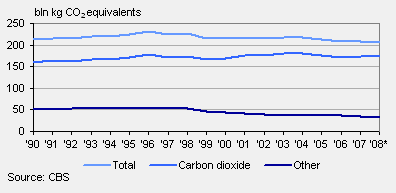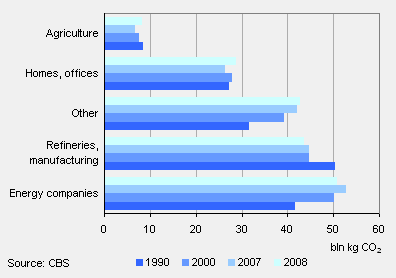Dutch greenhouse gas emissions fall further

The emission of greenhouse gases in the Netherlands fell for the fourth year in a row in 2008. At 206 billion kg CO2 equivalents, the emission was 3 percent lower than in 1990, the reference year for the Kyoto Protocol.
Kyoto Protocol
Under the Kyoto Protocol the Netherlands has committed to reducing the emission of greenhouse gases by an average 6 percent from its 1990 level in the period 2008–2012. Part of this reduction may be realised by the use of Dutch funds abroad. The Netherlands can buy up emission rights in other countries, for example, or fund projects which result in reduced emissions outside the Netherlands.
Emissions in the base year amounted to 213 billion kg of CO2 equivalents. In 2005 emissions of greenhouse gases in the Netherlands fell below this level for the first time.
Emissions of greenhouse gases

Less laughing gas in particular
The reduction is mainly the result of lower emissions of laughing gas (N2O) as a result of measures taken at factories producing nitric acid. This reduced emissions by 4 billion kg of CO2 equivalents. As these measures were introduced in the second half of 2007, the total effect was only visible in 2008.
Carbon dioxide emissions slightly up
Emissions of carbon dioxide (174 billion kg) rose slightly - by 2 billion kg of CO2 equivalents - in 2008 for the second successive year. This increase was caused by the use of more natural gas to heat houses and workplaces in the relatively cold months at the beginning and at the end of the year. The horticulture sector also consumed more natural gas as more combined heat and power installations were used to heat glasshouses and generate electricity.
Carbon dioxide emissions per sector

Less oil and coal used
The manufacturing and energy industries used considerably less petroleum and coal in 2008. The largest decrease was in the fourth quarter. This pushed down carbon dioxide emissions by 3 billion kg of CO2 equivalents. This decrease was not able to compensate the increase in carbon dioxide emissions from other sectors completely, however.
Kees Olsthoorn (Statistics Netherlands) and Kees Peek (Netherlands Environmental Assessment Agency)